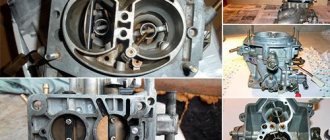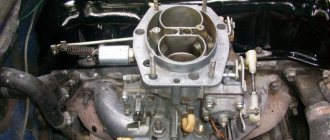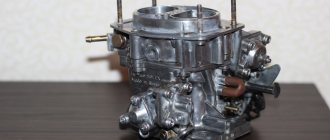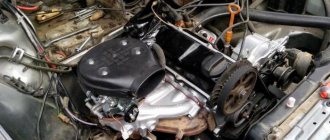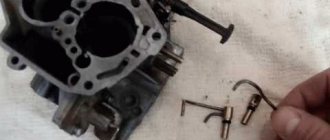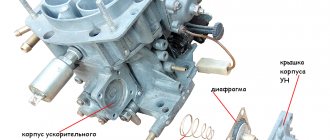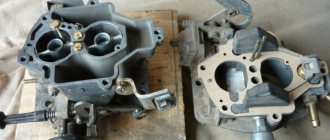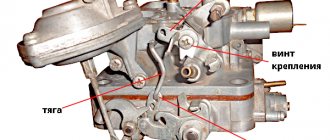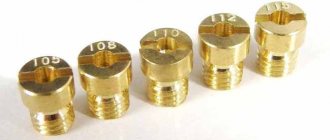Engine
Author temass
Date
Jul 18, 2017
4,027
Share
Solex-type carburetors have been used on domestic cars since the mid-80s. During this time, many motorists managed to get acquainted with them. Let's see what this part of the car is, what its capabilities are - and how to service it.
- Solex 21083 carburetor design for VAZ cars
- Starter and air damper
- Float mechanism diagram and fuel level
- Jets, diffusers and other replacement parts
- GDS chambers and engine idling
- Economizers
- Acceleration pump
- Press on the gas: operating principle of Solex 21073 and other models
- Carburetor characteristics and price
- 21073-1107010 and other modifications of the Solex carburetor
- Setting up and adjusting the carburetor
- Solex carburetor maintenance: adjust or replace?
- Solex repair kit and carburetor adjustment
Press on the gas: operating principle of Solex 21073 and other models
The principle itself, on which the operation of any modification of the Solex carburetor of any modification is based, has been unchanged for many years.
The carburetor circuit consists of two main parts:
- Float chamber.
- Mixing chamber.
In the float chamber, the fuel coming from the gas tank accumulates in the optimal amount for carburetor operation. As it is consumed, its level changes - and the inlet valve allows new portions of gasoline to pass through.
In the mixing chamber, fuel is mixed with air through a jet and atomizer. During the intake phase, the pressure in the chamber drops and air sucks gasoline inside. Evaporating and mixing with air, the fuel turns into a combustible mixture, which subsequently enters the engine cylinders and ignites there. The energy released during the ignition (in fact, explosion) of the fuel in the cylinder forces both the engine and, through it, the electrical system - and ultimately all other mechanisms of the car - to work.
- Google+
- LJ
- Blogger
Carburetor accelerator pump device
An accelerator pump is one of the carburetor components that supplies the fuel mixture when the throttle is open. This unit operates regardless of the air passing through the diffusers. During sudden acceleration, the carburetor is unable to supply the required amount of fuel to the cylinders. To neutralize this effect, an accelerator pump is needed. Its purpose is to speed up the supply of fuel to the cylinders.
This device ensures uninterrupted fuel supply during acceleration. At the same time, the acceleration of the car becomes sharper and smoother. Carburetor accelerator pump design:
- accelerator pump diaphragm (together with its head);
- drive lever;
- suction valve;
- fist on the throttle axis;
- carburetor accelerator pump discharge valve;
- spray;
- damping springs and suction stroke springs.
Carburetor characteristics and price
Solex brand carburetors have the following characteristics:
- The diameter of the mixing chambers is 32 mm.
- Diffuser cross-section – 21 mm (1 chamber) and 23 mm (2 chamber);
- Air damper gap – 2.5 mm;
- Throttle clearance – 1.1 mm;
- Bypass diameter – 0.7 mm;
- The diameter of the needle valve is 1.8 mm.
As of April 2021, the price of a carburetor is from 4050 rubles. up to 7000 rub. – depending on modification and completeness.
- Google+
- LJ
- Blogger
Device
Solex carburetors are manufactured for installation on 1.5-liter engines of VAZ cars.
Solex carburetor.
Differences between SOLEKS and DAAZ:
- presence equipped with a solenoid valve that regulates the fuel supply at idle
- the presence of a heating system for the air-fuel mixture, which is connected by hoses to the engine cooling system.
The carburetor consists of a cover and a body, which includes:
Solex device.
- float chamber
- starting system
- idle system with electromagnetic valve
- main dosing system
- transition system
- econostat
- economizer with accelerator pump.
21073-1107010 and other modifications of the Solex carburetor
Today, the following carburetor models are available on the auto parts market:
- 21083 is a universal model, suitable for any engine with a capacity of not more than 1500 cc. cm. It makes no sense to install it on larger engines: at high speeds it will “strangle” the engine, the cross-section of the diffusers does not allow creating a fuel mixture of the proper composition. However, adjusting the Solex carburetor of this modification, using additional parts from the repair kit and mechanical grooves allows you to create any other Solex model based on 21083.
- 21053 is a model more suitable for the longitudinal engine from the VAZ-2105. With minimal adjustments it can be used on any engine of the appropriate size.
- 21073 – “Nivovsky” engine, can be used on engines with a volume of up to 1700 cc. see. The main difference is two fittings for recirculation.
- 21041 is the only Solex suitable for engines over 1800cc. see. Available in several modifications, the main difference between which is the presence or absence of a fitting for the vacuum ignition detector.
In general, if you have the time and desire, adjusting the Solex carburetor allows you to use them on any engine. The only difference is at what speed level they stop doing their job. So, for example, if you need a torquey and powerful engine at low speeds, you can install 21083 even with a volume of over 1.5 liters, but at speeds over 4.5 thousand the engine will simply suffocate.
Description
Solex (Soleks) is a peptide lotion for restoring hair thickness. Available in special ampoules (15 pieces per package). Using this cosmetic product, you can transform your curls quickly and easily. The main components of the care product:
- A balanced peptide complex is a highly effective hair growth product. Additionally adds volume and also slows down the aging process of hair follicles.
- Mesotherapy complex DMAE – enhances oxygen metabolism, increases the energy status of the hair follicle.
- Ginkgo Biloba extract – makes hair dense, strengthens roots and microcirculation.
Setting up and adjusting the carburetor
- Google+
- LJ
- Blogger
Setting up a Solex carburetor includes the following stages:
- Adjusting the fuel level. To do this, you need to remove the top cover and measure the gasoline level in the float chamber. Normally there should be 24-25 mm. If there is too much gasoline, you need to remove the excess and bend the float holders. If it is too small, then bend it in the opposite direction.
- Idle speed adjustment. This is done by rotating the quality screw with a screwdriver. Normally, stable operation should be at 850 rpm.
- A selection of jets. You should start with the fuel for the first chamber, and then move on to the air.
- UN adjustment. Normally, the jet should fall between the diffuser and the damper. In this case, the fuel should flow in a trickle, not drops.
- Google+
- LJ
- Blogger
How to check and repair the accelerator pump of a Solex carburetor
Preparation for testing the Solex accelerator pump is no different from preparing the accelerator pump for a DAAZ Ozone carburetor. In the same way, fuel is pumped into the carburetor and the top carburetor cover is removed.
Checking the operation of the Solex accelerator pump
Turn the throttle lever and watch how injection occurs in the carburetor. The jets from the sprayers should be smooth, strong, free of breaks, and not touch the walls and axis of the throttle valve. The injection must last for at least two seconds.
If the stream is weak and crooked, then you should clean the channels, sprayer, jets and valves. If jets of fuel hit the chamber walls, you need to adjust the position of the spray nozzles using pliers.
Solex carburetor accelerator pump repair
Repairing the Solex accelerator pump, as in the case of the DAAZ system, must begin with repairing the nozzles. The sprayer is carefully removed using a screwdriver. You need to shake it immediately to check for the presence of a discharge valve ball. In domestically produced carburetors, there are known cases where the ball was forgotten to be installed at the manufacturer's plant. Usually, if no sounds are heard, then there is significant pollution. If you cannot clean the element, it should be replaced with a new one. During the cleaning process, both spouts must be thoroughly blown out with compressed air. If this procedure does not help, the spouts are soaked in a special solution for a couple of hours and the blowing is repeated. If this does not help, then a replacement is needed.
Accelerator pump valves and channels
If there is no strong jet, you need to clean all the valves and channels of the UN carburetor. They are cleaned with wire, followed by washing and blowing.
The hole from the sprayer is filled with acetone and cleaned with a toothpick. To clean the channel hole, you need to remove the spring and diaphragm. The hole itself is cleaned with thin wire and blown through. The float chamber also has a hole, which is cleaned in the same way.
During assembly, be sure to check the condition of the diaphragm. If there are abrasions or damage, it is replaced with a new one.
When the accelerator pump cover is put back on, you need to turn the pump lever all the way so that the diaphragm stretches. Only after this are the screws tightened.
Many people are afraid of the process of repairing the carburetor accelerator pump, but if you have too much time, you can do this procedure yourself, unless, of course, you are afraid of the monotonous cleaning process.
If you have any questions, leave them in the comments below the article. We or our visitors will be happy to answer them
Solex carburetor maintenance: adjust or replace?
Carburetor maintenance includes:
- changing consumables;
- cleaning parts (nozzles, injectors, etc.);
- adjustment of mechanical parts (flaps, rods, etc.);
- checking for leaks.
The maintenance procedure (TO) is established by the manufacturer. In addition, if malfunctions are detected, you should either adjust the parts or replace the faulty ones.
- Google+
- LJ
- Blogger
Solex carburetor trigger membrane - Replacement
Hello Old Man.) I think two weeks ago, my Kopeechka with DAAZ, Solex 21053 began to act up. The first symptom was a poor start in the morning, when the car was cold. Looking ahead, I will immediately say that the problem was in the switch, the contactless ignition system. I mentioned this in a previous publication. But in another case, the reason for poor cold starting may be the membrane of the starting device. The very purpose of the starting device is to facilitate cold starts.
If you have never climbed into a carburetor, there is no need to be afraid. Everything is simple here, this is not a rare American or German car. The trigger cover is located directly under the plastic screw for adjusting the amount of mixture. The lid is screwed on with four small screws for a Phillips screwdriver. To unscrew the latter you will need a small, but with a good grip, Phillips screwdriver.
OLD and NEW membrane
But let's go back a little - first we can buy a membrane / diaphragm for the starting device. It cost me only 30 hryvnia, which today is 1 dollar and 10 cents. Then we unscrew those four screws and pull out the metal cover. And by the way, did you notice the screw located in the middle part of the lid? — it is for adjusting the starting gap. The point is that the membrane we are talking about now, through a special channel, with the help of a vacuum coming from under the throttle valves, slightly tightens the air damper rod and opens it slightly for a short time when the engine starts (this should be the case if the system is working properly) . And the screw in the central part of the cap serves to adjust the gap to which the air damper will open during startup. But for now we are not touching this screw. But I’ll say right away that the starting gap on Solex should be 3mm. You can even check it using the leg of an old membrane, because its diameter is just 3mm. We simply insert the leg into the hole of the slightly open throttle so that it fits tightly into the gap between the air damper and the carburetor body - this will be 3mm. Adjustment is carried out by unscrewing the locking nut around the adjusting screw and unscrewing or tightening the screw.
STARTING DEVICE CASE with COPPER CHANNEL supplying VACUUM behind the MEMBRANE
Let's return to replacing the Solex carburetor starting membrane. We remove the lid carefully, because there is a spring installed under it. Then, note that the installed membrane has a leg that interacts with the air damper rod. It is L-shaped and in order to pull out the membrane, the air damper must be closed at some moments and open at others. This, together with scrolling the membrane first to the right and then to the left, will allow you to pull out the membrane.
TRIGGER COVER, SPRING, (the hole in the cap must be aligned with the vacuum supply channel)
When installing a new membrane, note that there is a hole in the starter cover - it should connect to the vacuum channel on the carburetor side.
Perhaps, in your case, the reason for the not very good launch lies precisely in this membrane. Once in a while, it is advisable to change the membranes of the accelerator pump, economizer and starting device.
LOOK AT THIS too)
Signs of carburetor malfunction
Signs of a malfunctioning Solex carburetor are:
- inability to start the power unit;
- complicated starting of a cold or hot engine;
- unstable idle;
- idle speed is too high or too low;
- increased gasoline consumption;
- reduction in engine power characteristics;
- jerks and dips when pressing the accelerator pedal sharply.
Let's take a closer look at each of the symptoms in the context of possible malfunctions.
The engine does not start at all or starts but immediately stalls
If a vehicle's engine does not start (with a known-good ignition system), it is possible that fuel is not getting into the cylinders. To check whether it enters the intake manifold, you need to remove the air filter housing and turn the throttle valve drive sector 2-3 times, observing the “spouts” of the sprayer. The fuel from them should spray out in thin but continuous streams. If this does not happen, it is worth checking the operation of the fuel pump, as well as the condition of the carburetor strainer.
It is also possible that the fuel valve needle may jam in the closed position, blocking the flow of gasoline into the float chamber. In order to return the needle to its normal position, it is enough to gently hit the carburetor body with something (for example, a key). In the future, the needle valve will need to be replaced.
If the engine starts and immediately stalls, this may be the result of a lean fuel mixture or a faulty solenoid valve. In the first case, it is necessary to check the intake pipe for leakage of foreign air, and also adjust the quality of the mixture.
To check the solenoid valve in this situation, disconnect the power wire from it, turn on the ignition and touch its contact with the tip of the wire several times. When touched, a characteristic click should be heard, indicating that the electromagnet is triggered. It would not be superfluous to unscrew the valve, inspect and clean its nozzle with a stream of air, and also check the condition of the rubber gasket.
Difficulty starting a cold engine
Typically, problems with starting a cold power unit occur due to incorrect adjustment or malfunction of the starting device. If during start-up the air damper does not completely close the channel, this leads to an excessively lean fuel mixture. At the same time, the engine “grabs” in places, but still stalls. Incomplete opening of the damper, on the contrary, leads to over-enrichment of the combustible mixture, which increases gasoline consumption and may also cause detonation.
This problem is eliminated by adjusting the starting device.
Difficulty starting a warm engine
The main reason for the difficulty of starting the engine “hot” is also the over-enrichment of the mixture. It can be caused by incorrect adjustment of the starting device, as well as an excessively high level of gasoline in the float chamber. In the latter case, fuel is overfilled, which, again, leads to an increase in its consumption.
“Overfilling” is a fairly common phenomenon for Solex. If, looking at the gasket between the carburetor and the cover, you find that it is wet, and there is a persistent smell of gasoline in the engine compartment, there is an “overflow”. It may occur due to:
- incorrect setting of the float mechanism;
- problems with the fuel valve needle (needle sticking in the open position);
- float damage;
- the float hitting the chamber wall.
To eliminate this problem, it is necessary to disassemble the carburetor, check the valve and adjust the float mechanism.
Unstable idle
Normal idle speed of the power unit is one of the main criteria for assessing the performance of the carburetor. Its violation may be caused by:
- contamination of jets and XX channels;
- breakdown of the solenoid valve;
- malfunction of the EPHH control unit;
- damage to the rubber seal (ring) of the fuel quality screw.
Clogged nozzles can be eliminated by washing and purging them. The faulty valve, EPHH block and seal must be replaced.
Idle speed too high or too low
Engine speeds that are too high or too low when idling may result from:
- contamination of the air or fuel nozzle channels;
- suction of excess air;
- improper adjustment of idle speed (quality-quantity);
- too high or low level of gasoline in the float chamber;
- incomplete opening or closing of the air damper.
This malfunction can be eliminated by adjusting the carburetor after cleaning and flushing it.
Increased fuel consumption
The following carburetor malfunctions can lead to excessive fuel consumption:
- malfunction of the storage economizer system;
- incorrect adjustment of the composition of the combustible mixture;
- clogging of air jet channels;
- incomplete opening of the air damper;
- The fuel level in the float chamber is too high.
The problem of increased fuel consumption is solved by diagnosing and adjusting the carburetor.
Reduced engine power
A decrease in the power performance of the power unit is caused by a lean fuel mixture. At the same time, the car takes a long time to accelerate, and when you sharply press the accelerator pedal, the engine “chokes” and short-term dips appear.
The reasons for this phenomenon may be:
- incorrect adjustment of the mixture composition;
- air leak;
- low level of fuel mixture in the float chamber.
Dips, jerks
The occurrence of jerks and dips under engine load occurs due to:
- clogged strainer on the carburetor inlet fitting;
- clogging of the fuel nozzle;
- air leak;
- low fuel level in the float chamber;
- accelerator pump malfunction.
